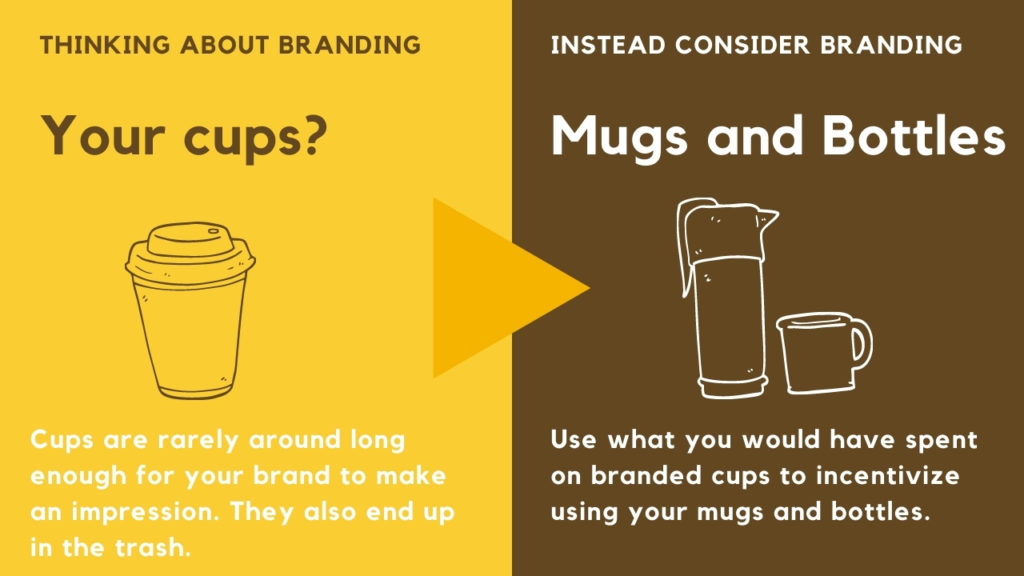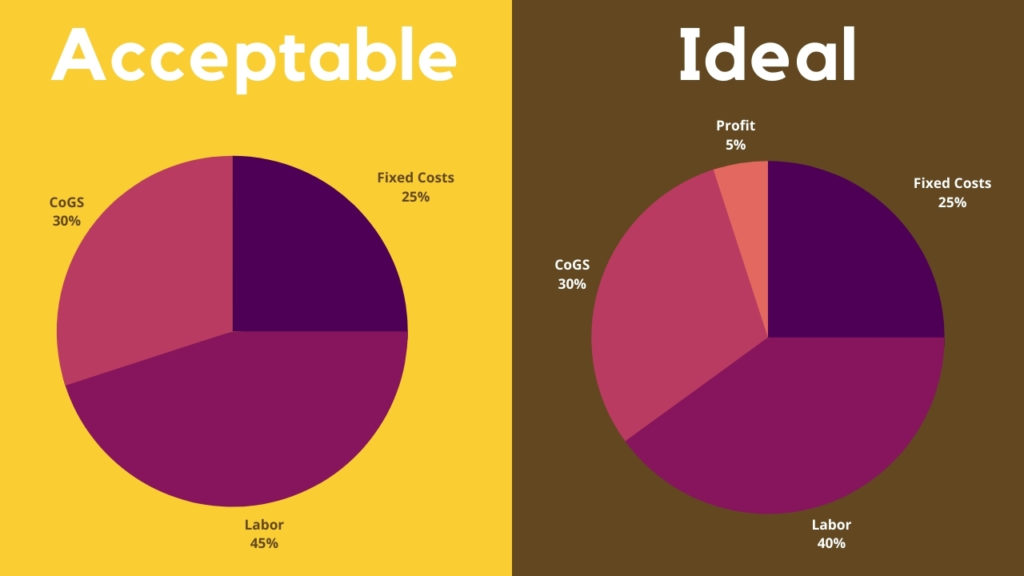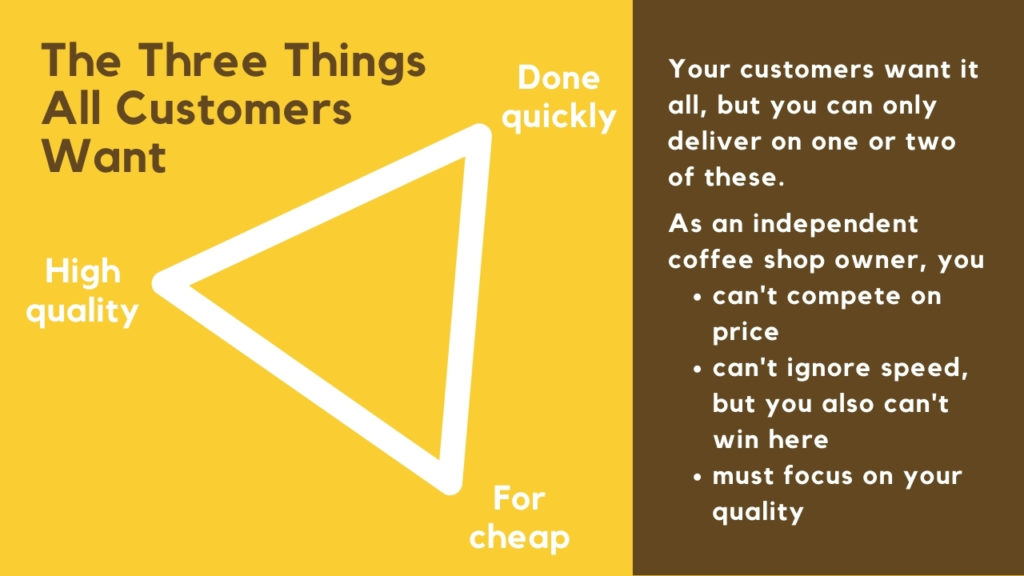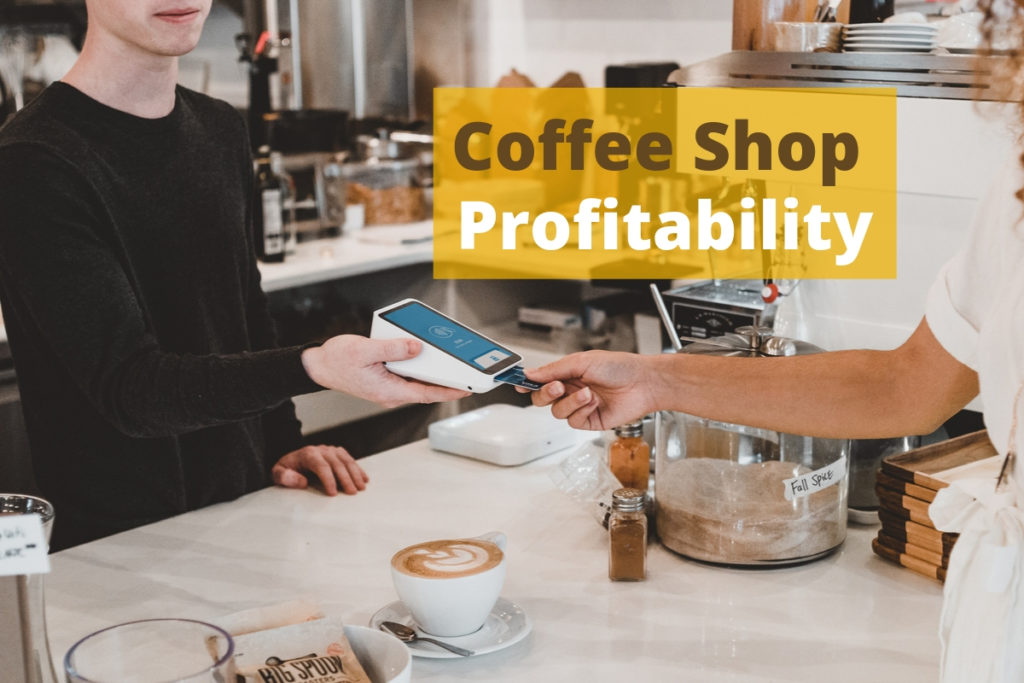The biggest hurdle for any new coffee shop: how to make money in coffee.
There is a lot of potentially complex discussion we can have about this, but let’s try to make it simple. The most basic equation for profit is:
Profit = Income – Expenses
You’ve seen this equation before. You earn money and you have to spend money. Anything left over is your profit. Luckily we only really need to add one more variable to make this a useful discussion.
Profit = (Avg. Purchase Amount * # of Purchases) – Expenses
This should also be pretty simple. We broke income into the average amount of money a customer pays times the number of customers or purchases you have. This is all we need.
There’s obviously a lot more we can (and should!) consider, but to get started thinking about running a coffee shop, these three variables are all we need to keep in mind.
So here is how to control these three variables, from easiest to hardest.
How to keep your coffee shop costs low
Controlling costs is certainly an important aspect of reaching profitability, but it’s also the variable you have the least influence over as a coffee shop.
Basically, controlling costs is a lot more about ticking boxes than being creative. Still, there are a few things you can do to make turning a profit easier.
Controlling labor
Labor is usually one of if not the most expensive costs coffee shops have. You should shoot for around 35%-45% of your overall income to be spent on labor. Much higher than that and you’re not leaving much room for any kind of profit.
If you do find yourself paying 50%, or even 60% (yikes!) for labor, here’s how you get it under control.
Cut aggressively. If you don’t need two people to be on the floor, why pay for it? The expectation for all your employees should be they can and will be cut if it is slow.
It’s a bummer to be cut and make less money for a day, but it’s the reality working in a coffee shop. You can try to distribute cuts across your staff to make sure no one is getting the short end of the stick.
Knowing when to cut is easier if you have a POS that gives you graphs of transactions, but you can always create your own graphs if you need to. You’re looking for trends when transactions start to go down. It might be different depending on the day of the week and the season, but you don’t need to be exact.
This tells you when to start looking to cut people. This also means you’ll have to spend more time on the floor, but that will also help your labor costs. It’s a win-win. Once you get to the time when transactions usually die down and things are indeed looking slower for the day, it’s time to tell an employee to head home.
Practice efficiency. It can be easy for new and even experienced baristas to get comfortable with their speed and feel like they’re going as fast as they can. Actually there are tons of ways to speed up. First of all, if you’re not finishing lattes in about 1 minute and 30 seconds, you can go faster.

Run drills to assemble drinks as fast as possible. You can turn these into friendly competitions among your staff, often called “crush-the-rush”.
If you’ve got the one drink speed down, practice setting up multiple drinks at once. As long as you’ve got at least two group heads, you can knock out as many as four drinks within about 30 seconds of each other.
Understand your labor needs. This one sounds simple, but it’s not always obvious. If you’re being stretched thin, make sure you evaluate whether bringing another person on is actually the right move. Sometimes it might mean cutting back on certain things or menu items, but that’s just the name of the game.
As an owner, you should expect to be on the floor more than any employee for at least the first year. Some owners get by without doing this, but it’s rare. This is your business, after all, it’s on you if it’s not working.
Controlling cost of goods
When you see the price tag of certain goods like syrups or coffees, it can be tempting to switch providers or start doing things yourself. The actual answer is rarely so straightforward.
Let’s take an example applicable to many coffee shops: branded paper cups.
The decision comes down to three possibilities.
- Not having branded cups
- Paying for branded cups
- Buying a stamp or sticker and branding the cups yourself
Not having branded cups is obviously the cheapest way to go, but it doesn’t allow for marketing.
Paying for branded cups is easy, but pretty expensive.
The stamp or sticker route seems like the perfect compromise which is why it’s so common. But does it actually make sense? Depends.
Stamping cups involves a good amount of costly labor. “Well, baristas can stamp cups during downtime,” you might say.
Sure, but stamping isn’t trivial labor. It’s a highly repetitive motion that mirrors the repetitive labor baristas are already doing.
You want your staff to get repetitive stress injuries? Because that’s how you end up with a bunch of unhappy and injured baristas who can’t work.
There’s also the issue of “doing it during downtime”. There is definitely downtime working at a coffee shop, but if you have such consistent downtime that baristas can stamp hundreds of cups, then why aren’t you cutting them to save on labor in the first place?
Finally, the benefit of stamped cups is marginal. After all, stamped cups get thrown out eventually. You know what’s not a great place to advertise? In a trash can.

We’re not saying stamped cups are never a good idea, just like we don’t want to say that changing your supplier or opting to make something from scratch is also never a good idea. It’s just that the knee jerk reaction and seemingly simple solution is not necessarily right.
There are no simple solutions. Everything has pros and cons that you have to evaluate. In these situations it often makes more sense to just raise your prices (as we discuss below).
Coffee shop budgeting
When controlling costs, it’s essential to have a budget. Not just a “I have a pretty good idea of what things cost” but a real written out budget that you regularly look at and update.
Everyone’s budget will be a little bit different, but here are the essential points.
Fixed Costs
Things like rent and insurance are unlikely to change month to month and can be considered fixed costs. These are the easiest things to account for since they are always the same.
Variable Costs
Variable costs are things like labor, cost of goods, and maybe marketing if you’re spending money on it. You should be making a projection of what you think these costs will be, then comparing them to what the costs actually are.
It’s good to do this comparison at least every month, but even better to do it weekly for things like labor to catch it before it gets out of control.

Income
Like variable costs, you should project income then compare it to actual income at least once a month. As you’re open for longer, you will get better at this. You’ll have more data to look at and a better understanding of seasonality and your specific market.
Some general truths to expect:
- Revenue will be way down in January and February. Use that time to train up your staff and improve processes in your shop.
- Offering drinks appropriate to the season will often be a big revenue boost.
- Most shops can expect a spike in revenue in the morning and around lunch. Unless you have a full menu you’re unlikely to do better than those two times.
- Weekends are often better for shops in city centers, while weekends are often worse for shops that rely on commuters.
We spend quite a bit of time on this in our coffee shop startup course.
How to get more customers into your coffee shop
When thinking about growth, usually the first natural step is to think about getting more customers. Getting more customers is important, but it’s not where you should focus most of your efforts (that’s the next section).
Still, you can’t ignore the need to get more people in your door, especially at first. Here are a few key ways to do that.
Maximizing your location
A coffee shop’s location is unquestionably one of the most important factors that determines whether it succeeds or fails.
When looking for your location, traffic is the name of the game. In urban centers, it’s about foot traffic. Car traffic should basically be ignored unless you have a great parking situation.
In suburban or rural areas, car traffic becomes more relevant. Your customers are more likely to have cars and use them to commute, so catering to cars makes sense.
An easy way to figure this out is to look at any major chains near you or in neighboring towns. They put millions of dollars into market research. They know what kind of model should work.
Whether you do a similar model or do the opposite depends on how well you know your own market, but be careful about doing things differently for the sake of it. If your only competition is a big chain, you’re already going to be sufficiently different to attract business. You’re an independent shop, after all. No need to overdo it.
Of course, none of this is what to do when you’re actually open. You can find the perfect location, but then you have to take advantage of it.
There are a ton of creative ways to use your location, but here are a few ideas to get you started:
- Signage. The most basic thing is to just make sure your space is visible to the traffic you’re trying to attract. Cities will have different rules about what kinds of signage you can have, but A-frames and signs that stick out perpendicular to your shop’s front door are always good to attract walkers. But larger freestanding signs are better for cars.
- Partner with businesses around you. This is an underrated tactic that can come in even when you’re looking for locations. Think about a customer running errands or on a commute. Are there any other businesses nearby that would make the trip even more convenient? Get friendly with other businesses around you. Bringing free coffee every so often makes you very popular. Even if the business isn’t an obvious partnership, you never know when being on good terms will come in handy for cross promotion.
- Strengthen your aesthetic. You might feel strongly about matching the local character with your space or you might want to stand out. Either way, go for it full force. When someone looks into your shop, you want them to think “oh wow”. Even if a customer doesn’t come in right away, you want to stick in their mind.
Customer service that brings customers back
A lot of independent shops cite “better service” as a reason their customers prefer them over a big chain, but what does that really mean?
Speed. Bigger chains absolutely have the advantage of speed. Their processes are laser focused and their machines are designed for extremely quick service. Unfortunately, speed is one of the things customers care about the most. You can’t beat a chain on speed.
So if it’s not speed, what about independent customer service keeps people coming back? You might say friendliness, and that certainly can be true. Chains can be a little hit or miss when it comes to friendliness, but so can independent shops. If you want to win on friendliness, you absolutely need to hire for personality.
We talk more about hiring baristas in our article about interview questions, but one of the crucial decisions you have to make as an owner is whether you can train people up.
In our opinion it’s not really a choice at all, you must be knowledgeable enough to train an employee on making coffee so you don’t miss out on the personalities you want in your coffee shop.
It’s really, really hard to train people on striking up organic conversations that brighten your customers’ days. It’s comparatively easy to train people how to make coffee.
Knowledge. The real benefit independent shops have over chains is knowledge. A chain employee will never be as knowledgeable about coffee as an independent shop’s employee as long as you’re training right.

Customers who come into independent coffee shops are interested in coffee but probably don’t know a ton about it. You definitely don’t want to educate someone when they just want to get in and out, but if it’s slow it can be great to throw in a question about the coffee to see what they say. If they’re receptive, have a little conversation. Here are some starter ideas:
- “I love this ethiopian coffee. Do you have ethiopians often?”
- “How do you usually brew coffee at home?”
- “Have you tried any other good coffees lately?”
Helping customers appreciate your product more will make them feel better about the price.
Efficient Marketing
Coffee shops don’t have millions or even thousands of dollars to spend on marketing, but that’s alright. We have a whole article on free and low cost marketing techniques to check out.
The biggest thing to keep in mind with your marketing is to just make yourself easy to find. Shoving your brand in peoples’ faces rarely works, but being present does.
People want coffee. You want to be one of the first names they think of when it comes to coffee.
The best ways to do this are making sure your online presence is solid, being present in your community, and some cost effective advertising. Refer to the article above for much more in depth explanations.
How to make more money per transaction in a coffee shop
Maximize your coffee shop layout
Similar to the section above about your location, it’s equally important to make sure the inside of your shop is laid out properly. We have a whole article about coffee shop design, but here are some quick tips:
Customers tend to want to walk forward. Try to make the flow of your store make sense for someone walking forward. This makes customers immediately feel more comfortable.
Always lay out your pastries, merchandise, etc. in a way where customers can see it before they order. Run your line next to these items. This alone will get you some bigger purchases. Also make sure everything is well lit and presented nicely. Haphazard merchandise or messy food displays not only won’t lead to purchases, but give your whole shop an overall dirty look. This is something baristas should be checking on hourly. Little things to check regularly:
- Empty plates in the pastry case and crumbs
- Fingerprint smudges on the pastry case, counters, and windows
- Merchandise that isn’t stocked well or arranged well
- Stray towels that aren’t necessary
- Things that customers will grab themselves like creamer, napkins, utensils, etc.
- The floor between the door and the ordering area
If you have the space, try to separate the order waiting area from seating. This might mean you have less overall seats. That’s fine. It’s awkward for both waiting customers and seated customers to squeeze together. Usually you can accomplish this by having the center of your shop more open and pushing seating more towards the outside.
Upselling and Downselling
If you’re unfamiliar with these terms, they basically mean getting a customer to buy more by offering either an upgrade or a bundle of some kind. You can get into all sorts of psychological tricks, but straightforward is usually better for coffee shops. It sounds kind of corporate-y, but it really does help to just make asking if a customer wants food a standard part of any transaction. Ways you can do this while sounding natural:
- “Would you like any food with that? A lot of people who come in here like to get X.”
- “Awesome choice. If you’re interested, I highly recommend trying X with that.”
- “I’ve heard our X actually makes for a great breakfast/lunch. Do you want to add one on?”
When to raise your prices
Coffee shop owners are terrified of raising their prices. Don’t be!
In fact, you should regularly be raising your prices, at least once per year. Your suppliers will be. Your employees will want raises. Your utilities will cost more the more business you do. All that money has to be accounted for somewhere.
Just raise your prices! You can’t compete with a large chain on price, so don’t even try. You should be aiming to create a superior quality product and experience than one of those chains. Your best customers will care about that and keep coming back, even if you raise prices.
If you think you’re losing customers, the issue is never your prices. Yup, never.
The issue is your price doesn’t reflect something about your product. It might be the quality, it might be the service, it might be something else. But it’s not the price. Look elsewhere for the problem and make sure your prices are high enough to turn a profit.
Charge at least double what your product costs to make, often more. If the cost of goods goes up, it’s time for you to raise your prices to match.
Bonus coffee shop profitability tips
Staying knowledgeable and informed
To be, and to stay, successful in the specialty coffee industry, you’re going to need a substantial amount of knowledge and expertise. You also can’t become complacent once you’ve done the bulk of your research either! There’s always more to learn about the ever-growing coffee industry: new trends, new brewing methods, new coffees to try. Be in a constant mode of self-development so that you can make your coffee business the best it can possibly be.
There’s an enormous amount of coffee resources available to new, prospective, and existing business owners online for free or for a small amount of money (this is an investment worth making). Go to coffee workshops, coffee trade shows, and watch videos to learn new skills. No matter what you decide to use, any resources you can get your hands on will be helpful in your growth as a business owner and coffee entrepreneur.
Pay attention to cash flow
Cash flow is essentially making sure you have the right amount of money you need when bills come up. It’s crucial especially in your first year or so.
You might be pretty confident that you’ll make $10,000 this month, but if you’ve got a big bill on the 15th and your bank account isn’t full enough to pay it, it doesn’t really matter how much money you’re going to have. It matters how much money you have now.
That’s a problem a lot of new owners run into while they’re still trying to produce consistent revenue. You need to budget not only for opening but also ample runway. You should expect not to make enough to cover your bills for at least 3 months. A year if you want to be really safe.
What to do if you have a cash flow problem
This does not constitute financial advice. Talk to a professional before making any financial decisions for your business.
Many small business owners don’t take advantage of lines of credit, but LoCs can be perfect for tough spots.
A line of credit works like a combination of a credit card and a loan. You have a maximum you can draw from for a period of time, then when the period is up, you only need to repay whatever you actually drew out.
If things are looking tight but you’re confident it will even out given a little more time, a solution like this can carry you over. It’s essential you get your cash flow under control eventually though.
What do do with profit in a coffee shop
You did it! You made more money than you had to spend. What’s next?
Profit for a coffee shop can be used for two main things:
You can pay yourself
Many coffee shop owners wait until they’re profitable to pay themselves. This is an admirable idea, but often is not practical. Don’t feel bad if you need to build a salary for yourself into your shop’s expenses.
Still, if you do go with this approach, it’s finally time to get paid. All your hard work has led to this. Enjoy it. Talk to a tax professional about how paying yourself with profit works in your state.
You can reinvest in your business
This is the preferred method for most coffee shops because unexpected expenses can show up at the worst times.
Having a reserve is the most important thing to build first. If you can comfortably operate for three months without making a single dollar, you’re doing great. This will take some time to build though, so don’t expect to get there after just a year or two.
Another great use for profit is shop improvements. If there is new equipment that would make things easier or new fixtures that would make things nicer, go for it. Just don’t fall in the trap of upgrading things for the sake of upgrading them.
Where to go next
Our coffee shop startup course is the perfect next step to opening your own coffee shop. It’s our most comprehensive resource on opening and operating a coffee shop.

